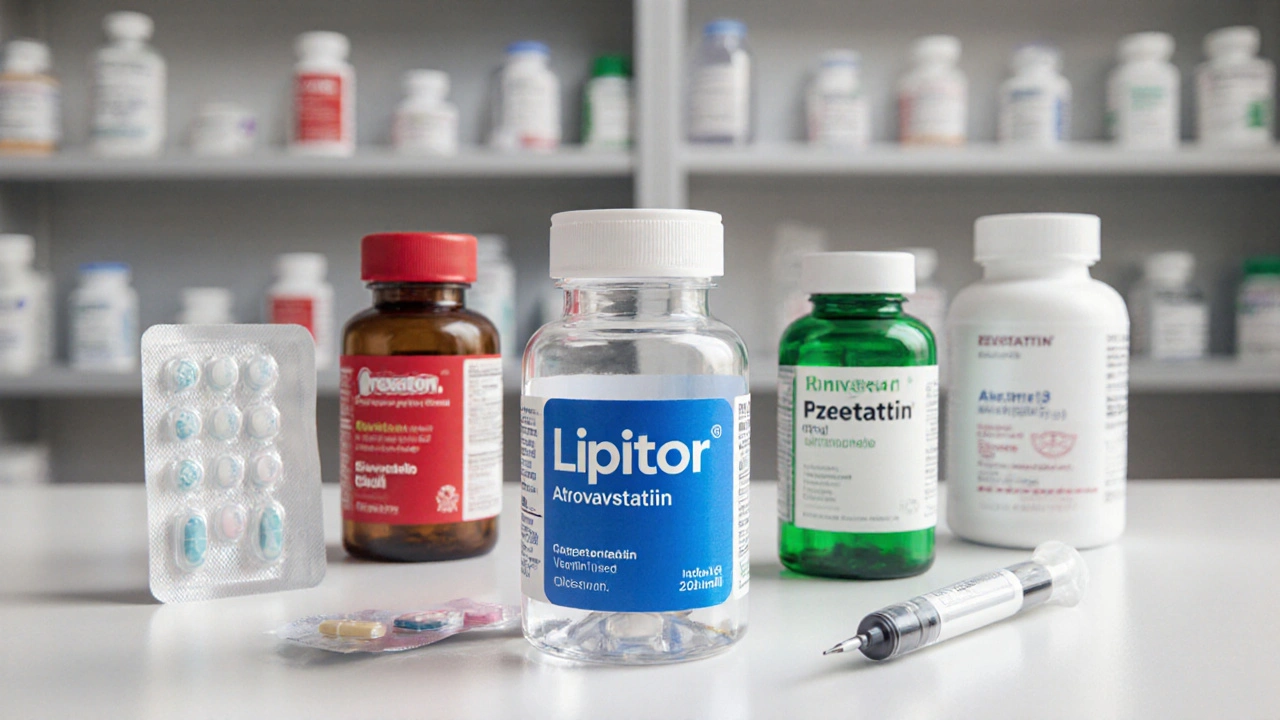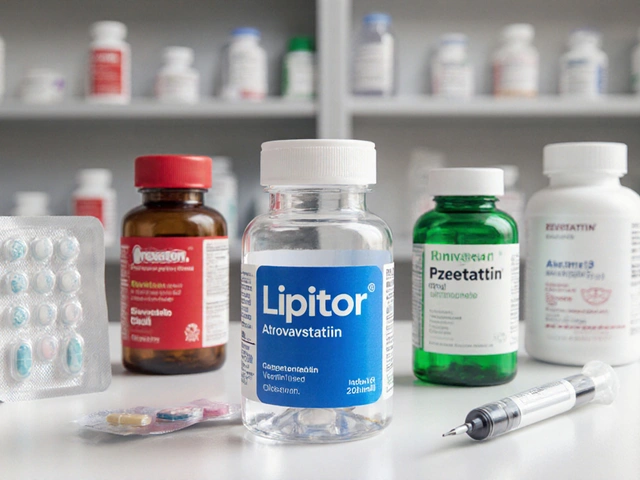Atorvastatin vs Alternatives Comparison Tool
Recommended Statin Based on Your Profile
Key Features of Recommended Option
Potential Side Effects
Cost Information
Quick Takeaways
- Atorvastatin (Lipitor) lowers LDL‑C by 30‑55% and is widely covered by insurance.
- Rosuvastatin (Crestor) offers the strongest LDL drop but can be pricier.
- Simvastatin and pravastatin are cheaper generics but work best for mild‑to‑moderate hypercholesterolemia.
- Ezetimibe adds about 15‑20% extra LDL reduction when combined with a statin.
- PCSK9‑inhibitor antibodies (e.g., alirocumab) are for patients who can’t reach targets on any oral regimen.
When you’re trying to decide whether Lipitor is the right cholesterol pill, the biggest question is how it stacks up against the other options on the market. Below you’ll get a clear, side‑by‑side look at the most common alternatives, the situations where each shines, and the trade‑offs you’ll face at the pharmacy counter.
Atorvastatin is a synthetic statin that inhibits HMG‑CoA reductase, the key enzyme for cholesterol synthesis in the liver. First approved by the FDA in 1996, it quickly became the world’s best‑selling drug because it can drop low‑density lipoprotein cholesterol (LDL‑C) by up to 55% at the 80mg dose. The drug is sold under the brand name Lipitor and is also available as a generic.
How Statins Work - A Brief Overview
All statins, including Atorvastatin, target the same enzyme (HMG‑CoA reductase) to cut the liver’s cholesterol output. The result is lower LDL‑C, a modest rise in high‑density lipoprotein (HDL‑C), and reduced triglycerides. Because heart‑attack risk tracks tightly with LDL‑C, every 1% drop in LDL translates into roughly a 1% reduction in major cardiovascular events.
Key Alternatives to Atorvastatin
When you hear “alternatives,” most doctors think of other statins, a cholesterol‑absorption blocker, or a newer injectable class. Each has its own potency, safety profile, and cost curve.
Rosuvastatin (brand Crestor) is the most potent statin on the shelf, delivering up to a 60% LDL cut at 40mg. It was FDA‑approved in 2003 and is prized for patients needing aggressive lowering.
Simvastatin is an older, less expensive statin that usually reduces LDL by 20‑40% at doses up to 40mg. It entered the market in 1991.
Pravastatin is a milder statin (15‑30% LDL drop) and is often chosen for patients who experience muscle complaints on stronger drugs.
Ezetimibe works by blocking intestinal cholesterol absorption. It cuts LDL an additional 15‑20% when paired with any statin.
Alirocumab (a PCSK9‑inhibitor monoclonal antibody) can lower LDL by 50‑60% on its own, but it’s injectable and carries a high price tag.

Side‑Effect Landscape
Statins share a core safety set: mild muscle aches (myalgia), rare rhabdomyolysis, and a small increase in liver enzymes. The likelihood of muscle symptoms rises with higher potency doses.
Rosuvastatin has a slightly higher chance of causing elevated glucose, which matters for pre‑diabetic patients. Simvastatin’s biggest red flag is a drug‑interaction risk with certain antifungals and antibiotics, especially at the 80mg dose (now discouraged by FDA).
Pravastatin is the most “muscle‑friendly” because it is hydrophilic and less likely to penetrate muscle tissue. Ezetimibe’s side effects are usually gastrointestinal (diarrhea, abdominal pain) and are mild.
PCSK9‑inhibitors can cause injection‑site reactions and mild respiratory infections, but overall they have the cleanest systemic profile.
Cost Snapshot (2025 US Market)
| Drug | Typical Dose Range | LDL Reduction | Monthly Cost (Generic) | Monthly Cost (Brand) | Key Side‑Effects |
|---|---|---|---|---|---|
| Atorvastatin (Lipitor) | 10‑80mg | 30‑55% | $10‑20 | $180‑200 | Myalgia, ↑ liver enzymes |
| Rosuvastatin (Crestor) | 5‑40mg | 45‑60% | $15‑25 | $190‑210 | Myalgia, ↑ glucose |
| Simvastatin | 5‑40mg | 20‑40% | $5‑12 | $120‑140 | Drug interactions, myalgia |
| Pravastatin | 10‑80mg | 15‑30% | $4‑9 | $115‑130 | Low muscle risk |
| Ezetimibe | 10mg | +15‑20% on statin | $12‑18 | $150‑170 | Diarrhea, abdominal pain |
| Alirocumab (PCSK9‑i) | 75mg Q2W | 50‑60% | - | $1,300‑1,500 | Injection site, flu‑like |
When to Choose Atorvastatin (Lipitor)
- High baseline LDL‑C (≥190mg/dL) - the 80mg dose can hit aggressive targets without needing a separate drug.
- Patients with established ASCVD who need a proven, outcomes‑based statin.
- Insurance plans that favor generic coverage - the low monthly price makes adherence easier.
- Older adults without severe renal impairment - Atorvastatin’s metabolism is hepatic, so dose adjustments are minimal.
When an Alternative Might Be Better
Rosuvastatin is the go‑to if your LDL goal is below 70mg/dL and you can tolerate a stronger drug (e.g., after a recent heart attack). It’s also useful when you need a lower pill burden - many patients stay on a single 20mg tablet instead of splitting higher Atorvastatin doses.
Simvastatin works well for cost‑sensitive patients with moderate cholesterol elevations. It’s also a decent choice if you’re already on a regimen that includes a CYP3A4 inhibitor, provided you keep the dose ≤20mg.
Pravastatin shines for people who have experienced muscle aches on other statins. Its hydrophilic nature reduces muscle exposure, so you often stay on therapy longer.
If you’re already on a statin but still above target, adding Ezetimibe is a cheap, evidence‑backed step before moving to a higher‑potency statin.
For patients with familial hypercholesterolemia or those who cannot tolerate any oral statin, a PCSK9‑inhibitor like alirocumab gives the deepest LDL cut, albeit at a premium price and injection schedule.

Practical Decision Tree
- Assess baseline LDL and cardiovascular risk.
- LDL ≥190mg/dL → Start Atorvastatin 40‑80mg or Rosuvastatin 20‑40mg.
- LDL 130‑189mg/dL → Atorvastatin 10‑20mg or Simvastatin 20‑40mg.
- Check insurance coverage.
- Generic preferred → Atorvastatin or Simvastatin.
- Brand coverage OK → Rosuvastatin.
- Monitor for side‑effects after 4‑6 weeks.
- Muscle pain → Switch to Pravastatin or lower dose.
- Elevated glucose → Consider Rosuvastatin at lower dose or non‑statin options.
- If LDL still > target, add Ezetimibe.
- If LDL still > target and high‑risk, discuss PCSK9‑inhibitor.
Common Myths About Lipitor and Its Rivals
Myth 1: “All statins are the same.” Reality - Potency, drug‑interaction profile, and genetic metabolism (e.g., SLCO1B1 variants) differ, influencing both efficacy and side‑effect risk.
Myth 2: “If you can’t tolerate Lipitor, you must stop lowering cholesterol.” Reality - Switching to a milder statin or adding a non‑statin can keep you on track.
Myth 3: “Statins cause dementia.” Large meta‑analyses up to 2024 show no credible link; the cardiovascular benefits far outweigh any uncertain cognitive signals.
Bottom Line: Picking the Right Pill
There’s no one‑size‑fits‑all answer. Atorvastatin (Lipitor) remains the workhorse because it balances potency, safety, and cost. If you need a stronger drop, have insurance that covers brand‑name drugs, or can tolerate a slightly higher side‑effect risk, Rosuvastatin may edge it out. For budget‑conscious or muscle‑sensitive patients, Simvastatin or Pravastatin are solid alternatives. When oral options fall short, toss in Ezetimibe or step up to a PCSK9‑inhibitor.
Frequently Asked Questions
Can I switch from Lipitor to another statin without a doctor’s visit?
No. All statins require a prescription, and a doctor needs to assess your risk, current dose, and any side‑effects before making a safe switch.
Is it safe to take Lipitor with a high‑intensity workout?
Yes, but stay alert for muscle soreness that lasts longer than typical post‑exercise aches. If pain persists for more than a week or you notice dark urine, call your doctor.
What’s the difference between brand Lipitor and generic atorvastatin?
The active ingredient is identical. Differences lie in inactive fillers, price, and sometimes the pill’s shape or color, which can affect adherence for some users.
Will adding ezetimibe raise my insurance costs?
Many plans cover ezetimibe as a “step‑therapy” drug after a statin, but co‑pay can be higher than generic statins. Check your pharmacy benefits for exact figures.
Are PCSK9 inhibitors ever used as first‑line therapy?
Usually not. They’re reserved for patients with familial hypercholesterolemia or those who cannot achieve targets on maximally tolerated statin+ezetimibe because of cost and injection requirements.





Trinity 13
October 9, 2025 at 21:58When you look at the landscape of cholesterol‑lowering meds, it’s clear that Atorvastatin has earned its crown not by accident but through relentless efficacy and accessibility.
First, the drug’s ability to slash LDL by up to 55 % at high doses gives clinicians a powerful lever for high‑risk patients.
Second, its generic form keeps the monthly price in the single‑digits for most insurance plans, removing a major barrier to adherence.
Third, the safety profile-mild muscle aches in a small minority and occasional liver‑enzyme bumps-has been studied in millions of users, giving us confidence in long‑term use.
Fourth, the pharmacokinetics of Atorvastatin, metabolized primarily by CYP3A4, mean that dose adjustments are rarely needed for kidney impairment, unlike some other statins.
Fifth, the drug’s flexibility across intensity levels-from 10 mg for moderate needs to 80 mg for aggressive targets-lets doctors tailor therapy without switching agents.
Sixth, the wealth of outcome data showing reduced myocardial infarction and stroke rates cements its place as a cornerstone of secondary prevention.
Seventh, when you factor in the cost‑effectiveness analyses, Atorvastatin consistently ranks among the most value‑for‑money therapies in cardiology.
Eighth, the drug’s compatibility with most other cardiovascular agents-beta‑blockers, ACE inhibitors, antiplatelets-means you can build a comprehensive regimen without fearing dangerous interactions.
Ninth, patient education tools, like the comparison chart in this post, empower individuals to understand why their physician chose Lip‑Lipitor over alternatives.
Tenth, the drug’s track record of generic competition ensures that price wars keep the cost low, a vital consideration for the uninsured and underinsured.
Eleventh, real‑world studies show that adherence rates for Atorvastatin surpass many brand‑only statins, translating to better population health outcomes.
Twelfth, the global reach of the medication-available in over 100 countries-means you can travel and stay on therapy without supply disruptions.
Thirteenth, the modest impact on HDL (a slight rise) adds a bonus benefit for comprehensive lipid management.
Fourteenth, the drug’s once‑daily dosing fits neatly into most people’s routines, reducing missed doses.
Finally, the bottom line is that Atorvastatin balances potency, safety, cost, and convenience in a way few other agents can match, making it the go‑to choice for most clinicians and patients alike.
Rhiane Heslop
October 13, 2025 at 09:18Statins are a matter of national health security and any attempt to undermine their proven superiority is a betrayal of our citizens.
Eric Parsons
October 16, 2025 at 20:38Atorvastatin’s efficacy stems from its high potency and predictable dose‑response, which allows clinicians to achieve LDL targets across a wide risk spectrum.
When comparing it to rosuvastatin, the latter may offer slightly greater maximal LDL reduction, but it often comes at a higher out‑of‑pocket cost.
For patients with moderate hypercholesterolemia and good generic coverage, atorvastatin remains the most cost‑effective option.
Conversely, individuals with very high baseline LDL or familial hypercholesterolemia may benefit from the stronger statins or combination therapy with ezetimibe.
Ultimately, the choice should be guided by therapeutic goals, tolerance, and insurance formularies, not by brand loyalty alone.
Mary Magdalen
October 20, 2025 at 07:58The claim that cheaper generics are somehow “inferior” is a myth propagated by pharmaceutical lobbyists to keep prices inflated.
Atorvastatin’s generic form delivers identical LDL‑lowering power as the brand name, and the safety data supports its widespread use.
If you’re willing to sacrifice health for brand prestige, you’re playing into a dangerous narrative that puts profit over patients.
Choose efficacy, not hype.
Dhakad rahul
October 23, 2025 at 19:18Bro, the statin showdown is like a Bollywood drama-full of twists, heroes, and that one villain called “cost” 😂.
Atorvastatin steps onto the stage with a massive 55 % LDL drop, stealing the spotlight from rosuvastatin’s 60 % cameo.
But the real twist? The generic version slashes the ticket price to pennies, making it the true champion for the masses 🎭.
Don’t let the glitter of a brand name blind you; the science lives in the molecule, not the packaging.
So, pop the generic, feel the power, and let your arteries thank you 🙌.
William Dizon
October 27, 2025 at 06:38Hey folks, if you’re weighing Lipitor against the other statins, think of it like choosing a reliable car – you want power, safety, and low maintenance costs.
Atorvastatin offers solid LDL reduction, a well‑known safety record, and an affordable price tag when you go generic.
If you have a high‑risk profile or need a more aggressive drop, rosuvastatin can be a good backup, but it often comes with a steeper price.
For most patients, especially those with decent insurance, start with Atorvastatin 10‑20 mg and monitor how you feel.
Always talk to your doctor before switching, but this is a great baseline to discuss.
Ira Bliss
October 30, 2025 at 17:58💪 Let’s crush those cholesterol numbers together! Atorvastatin gives you a powerful punch at a price that won’t break the bank, so you can stay focused on your goals.
Combine it with a heart‑healthy diet, regular walks, and the occasional dance‑break, and you’ll see the LDL melt away.
Remember, consistency is key – set a reminder, keep a pill box, and celebrate each small win with a smile 😊.
If side‑effects pop up, report them early; most are mild and manageable.
You’ve got this, and the community is cheering you on every step of the way! 🌟
Donny Bryant
November 3, 2025 at 05:18Atorvastatin is effective and cheap, making it a solid first choice for most patients.
kuldeep jangra
November 6, 2025 at 16:38When you sit down to plan cholesterol management, the first question should always be “what works best for my lifestyle and my wallet?”
Atorvastatin answers both of these concerns by delivering a strong LDL reduction while remaining affordable, especially in its generic form.
Moreover, the drug’s once‑daily dosing eliminates the need for complicated schedules, which is a major adherence booster for busy individuals.
If you compare the cost‑effectiveness tables, you’ll see that alternatives like rosuvastatin or ezetimibe can quickly outpace your budget, particularly if your insurance prefers generics.
That said, certain high‑risk patients may need a more potent statin, but the step‑up should be guided by lab results, not just brand appeal.
In many real‑world studies, patients on atorvastatin maintain better adherence rates, leading to lower rates of heart attacks and strokes over time.
Remember to pair the medication with a heart‑healthy diet rich in fiber, nuts, and omega‑3s – the synergy can amplify the drug’s effect.
Regular follow‑up labs every 3‑6 months will help you fine‑tune the dose and catch any side‑effects early.
Don’t forget that muscle aches are usually mild; if they become severe, a dose reduction or switch to pravastatin can solve the problem.
Your healthcare team is there to support you, so keep an open line of communication and stay proactive.
harry wheeler
November 10, 2025 at 03:58The statin debate often overlooks how different health systems subsidize drugs making generic atorvastatin a global staple
faith long
November 13, 2025 at 15:18First, let me make it crystal clear that anyone who dismisses atorvastatin as “just another pill” is actively endangering lives by spreading misinformation.
Second, the drug’s proven ability to cut LDL by up to 55 % is not a marketing gimmick but a hard‑won scientific fact backed by decades of trials.
Third, the generic version shatters the myth that only branded medications deliver results, offering the same molecular efficacy at a fraction of the cost.
Fourth, when you compare side‑effect profiles, atorvastatin’s mild myalgias are far less severe than the muscle toxicity seen with high‑dose simvastatin.
Fifth, insurance companies love this drug because it drives down overall healthcare expenditure by preventing costly heart attacks.
Sixth, the drug’s metabolism via CYP3A4 means it’s predictable, and clinicians can manage interactions without resorting to blanket discontinuations.
Seventh, the evidence shows a consistent reduction in cardiovascular events across primary and secondary prevention cohorts.
Eighth, recommending rosuvastatin over atorvastatin without a clear clinical justification is a disservice driven by pharmaceutical bias.
Ninth, patients who stay on atorvastatin maintain higher adherence rates, a direct result of its tolerability and affordability.
Tenth, the global availability of the generic ensures continuity of care for travelers and expatriates alike.
Eleventh, clinicians should focus on individualized dosing rather than brand loyalty, using the drug’s flexible range from 10 mg to 80 mg to meet patient needs.
Twelfth, the modest increase in liver enzymes can be monitored easily, whereas the rare cases of severe rhabdomyolysis are not exclusive to atorvastatin.
Thirteenth, the drug’s impact on lowering overall mortality is undeniable and should be highlighted in patient counseling.
Fourteenth, any narrative that demonizes generic atorvastatin attacks the very foundation of evidence‑based medicine.
Finally, the bottom line is simple: choose atorvastatin, monitor responsibly, and avoid the pitfalls of marketing hype.
Danny Wakefield
November 17, 2025 at 02:38Some people think the whole cholesterol game is just a smoke‑screen to keep us on a billion‑dollar pharma treadmill, but the data on atorvastatin’s LDL‑cutting power is hard to fake.
The real conspiracy is that insurance companies push the cheapest generic to keep the public quiet while the “premium” brands get all the hype.
If you dig into the trial registries, you’ll see that atorvastatin consistently outperforms newer drugs on hard endpoints.
Don’t let the “big pharma” narrative distract you – the science is out there, waiting for you to read it.
Stay skeptical, stay informed, and keep your heart healthy.
Samantha Dean
November 20, 2025 at 13:58From a philosophical standpoint, the selection of a lipid‑lowering agent reflects the balance between efficacy, accessibility, and the ethical duty to do no harm.
Atorvastatin exemplifies this equilibrium, offering substantial LDL reduction while maintaining a relatively benign adverse‑event profile.
When contrasted with rosuvastatin, the marginal benefit in LDL lowering must be weighed against increased cost and potential glucose dysregulation.
Thus, the rational clinician should prioritize medications that provide the greatest public health benefit per dollar spent.
Ultimately, the decision should serve both individual patient outcomes and societal resource stewardship.
Vanessa Peters
November 24, 2025 at 01:18Let’s cut through the melodrama: atorvastatin dominates the statin arena because it delivers results without the unnecessary glamour of “premium” branding.
The so‑called “super‑statin” rosuvastatin may boast a slightly higher LDL drop, but its price tag and propensity for raising blood sugar make it a risky gamble.
If you’re looking for a drug that actually works for the masses, stick with the proven, cost‑effective atorvastatin.
Anything else is just a marketing illusion designed to pad the pockets of the elite.
Suzan Graafstra
November 27, 2025 at 12:38The heart is the drumbeat of our existence, and the cholesterol we carry is the rhythm that can either protect or betray us.
Atorvastatin, in its humble generic form, sings a steady, reliable tune that steadies the pulse of life.
When we chase the flashier notes of newer statins, we risk discord and financial strain.
Thus, the wisdom of the ancients whispers: choose the steady beat over the fleeting crescendo.
Randy Faulk
November 30, 2025 at 23:58In the comparative analysis of HMG‑CoA reductase inhibitors, atorvastatin demonstrates a favorable pharmacodynamic profile, achieving LDL reductions between 30 % and 55 % across its dosing spectrum.
The drug’s extensive post‑marketing surveillance data substantiate its safety, with myalgia incidence comparable to placebo in large cohort studies.
Cost‑effectiveness evaluations consistently rank generic atorvastatin as the optimal first‑line agent for both primary and secondary prevention of atherosclerotic cardiovascular disease.
Clinicians should, therefore, consider atorvastatin the cornerstone of lipid management, reserving rosuvastatin or ezetimibe for patients inadequately controlled on maximal tolerated doses.
Such a strategy aligns with evidence‑based guidelines and promotes fiscal responsibility within healthcare systems.
Brandi Hagen
December 4, 2025 at 11:18Alright, let’s unpack this with the precision of a surgeon and the flair of a Broadway star 🎭.
First, the pharmacology: atorvastatin inhibits HMG‑CoA reductase, the rate‑limiting step in hepatic cholesterol synthesis, which translates into a robust LDL decline that can reach the mid‑50s percent at the 80 mg dose.
Second, the economics: the generic version typically costs under $20 per month, a figure that dwarfs the $180‑plus price tag of the brand‑name Lipitor and even eclipses the cost of other high‑potency statins when insurance coverage is factored in.
Third, the safety landscape: while mild myalgia is reported in a minority of patients, serious adverse events such as rhabdomyolysis are exceedingly rare, especially when patients adhere to recommended dosing and avoid contraindicated drug interactions.
Fourth, the comparative potency: rosuvastatin may edge out atorvastatin in maximal LDL reduction, but the marginal benefit must be balanced against its higher propensity to elevate fasting glucose and its steeper price curve.
Fifth, adherence factors: once‑daily dosing, minimal dietary restrictions, and a well‑tolerated side‑effect profile all contribute to higher long‑term compliance with atorvastatin versus some alternatives that require multiple daily doses or have significant food interactions.
Sixth, the guideline perspective: major cardiology societies universally endorse atorvastatin as a first‑line therapy for both primary and secondary prevention, underscoring its evidence‑based superiority.
Seventh, real‑world outcomes: large registry studies reveal that patients on atorvastatin experience lower rates of myocardial infarction, stroke, and cardiovascular mortality compared to those on less potent or less affordable statins.
Eighth, patient empowerment: educating patients on the cost‑benefit ratio empowers them to make informed choices and avoid unnecessary financial strain.
Ninth, the future outlook: with ongoing development of even more potent PCSK9 inhibitors, atorvastatin will likely remain the backbone of lipid therapy, serving as the foundational agent upon which adjuncts are added.
Finally, the takeaway: if you’re seeking a statin that blends efficacy, safety, affordability, and guideline endorsement, atorvastatin stands unrivaled – embrace it, discuss it with your clinician, and let the numbers do the talking! 💪💊